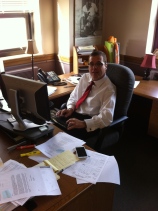This past  year I read a lot. I roamed through a whole set of authors and topics: works by David Foster Wallace, James Ellroy, Daniel Woodrell, Frank Bill, Bonnie Jo Campbell, Jaimy Gordon, and the whole genre of “Country Noir”; works by Mohsin Hamid, Eleanor Catton, Michael Lewis, Kenneth Rexroth, and Hilary Mantel; subjects like human migration, prehistoric art, the history of Maine, the history of European gardening, the 1929 stock market crash, and many, many others. My point here is simply that I read–I read–and this past year I have been especially conscious of this big-time commitment to reading that has defined so much of my life.
year I read a lot. I roamed through a whole set of authors and topics: works by David Foster Wallace, James Ellroy, Daniel Woodrell, Frank Bill, Bonnie Jo Campbell, Jaimy Gordon, and the whole genre of “Country Noir”; works by Mohsin Hamid, Eleanor Catton, Michael Lewis, Kenneth Rexroth, and Hilary Mantel; subjects like human migration, prehistoric art, the history of Maine, the history of European gardening, the 1929 stock market crash, and many, many others. My point here is simply that I read–I read–and this past year I have been especially conscious of this big-time commitment to reading that has defined so much of my life.
I have shared this commitment publicly with all of my colleagues in Simpkins Hall. For English and Journalism, this year was the year of reading. To some this may seem obvious—isn’t reading required in our discipline, in this field? Sure, yes, certainly—but reading and a reading life, a culture of reading, are not necessarily the same thing. I believe that the kind of reading I am talking of now is a serious commitment. Though the list above may suggest otherwise, it is certainly not dilettantism. It is serious. It is not exclusively pleasurable and it is not exclusively professional. It is, mostly, work, an intense laborious serious daily commitment. Let me explain.
Every morning I get up as early as I can and I spend at least 1 hour reading. I have a very specific ritual: I come downstairs, turn the heat up (or the air down), talk to our cat, make some really strong coffee, put on my robe and slippers and, finally, turn on my reading lamp and sit at my desk to read. It is quiet. It is often still dark outside. I settle in. And I read, just read—no writing other than a few notes, no working at the computer, no emailing, texting, or any kind of communication that is not printed on the pages before my eyes. This is a physical activity as much as an intellectual activity. I do it every morning, no matter what. I read anything and everything that interests me, and many things people suggest. But this kind of practice is not unique to me. Most people in our department live like this. Again, let me try to explain.
It is clear that, as a whole, our faculty read deeply this past year. One look at our research activity demonstrates this fact. This year, faculty members in English and Journalism published a total of 20 scholarly articles, three books, and two edited collections; they presented 30 scholarly papers at national and international venues. Add to this the fact that in the past two years our creative writers have published two novels and, literally, dozens of short stories, poems, and pieces of creative nonfiction. This is outstanding! And it shows that every single day of the year our faculty read outside of their normal, everyday activities—outside of the everyday, often very demanding work required for their teaching and their service to the University. They read, privately, and with intense seriousness.
Our creative writers, our professional writers, and our literary critics will all tell you this kind of reading, serious hard reading of serious hard books, is the activity that makes their writing possible. Indeed, in this way, we can think of their writing, all of these publications, as in large part a record of the authors’ own reading life. And this year all of this work became a little more public. This year, many faculty members tried to share their private reading lives with their students. So, the department’s culture was publicly defined, in part, by a reading group in the Fall that focused on David Foster Wallace’s final unfinished novel, The Pale King; by a reading group in the Spring that focused on Miguel De Cervantes’ masterpiece, Don Quixote; and by a communal novel writing group that met once a week at the Jackson Street Pub. What a great time to be in the Department of English and Journalism! What a great advance in our public culture in Simpkins! What a great year of reading!